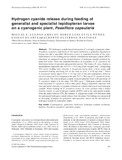| dc.rights.license | http://creativecommons.org/licenses/by-nc-sa/3.0/ve/ | |
| dc.contributor.author | Alonso Amelot, Miguel | es_VE |
| dc.contributor.author | Avila Nuñez, Jorge Luis | es_VE |
| dc.contributor.author | Duarte, Lisday | es_VE |
| dc.contributor.author | Oliveros Bastidas, Alberto | es_VE |
| dc.date | 2007-04-09 | es_VE |
| dc.date.accessioned | 2007-04-09T09:00:00Z | |
| dc.date.available | 2007-04-09T09:00:00Z | |
| dc.date.created | 2006-01-01 | es_VE |
| dc.date.issued | 2007-04-09T09:00:00Z | es_VE |
| dc.identifier.other | T016300003780/0 | es_VE |
| dc.identifier.uri | http://www.saber.ula.ve/handle/123456789/16809 | |
| dc.description.abstract | Hydrogen cyanide release during feeding of generalist and specialist lepidopteran larvae on a cyanogenic plant,
Passiflora capsularis.
(Alonso Amelot, Miguel; Avila Nuñez, Jorge Luis; Duarte, Lisday y Oliveros Bastidas, Alberto)
Abstract
The hydrogen cyanide-based interaction of a strongly cyanogenic plant, Passiflora capsularis, and larvae of two insect herbivores, a generalist (Spodoptera frugiperda) and a specialist (Heliconius erato), is examined in terms of the combined kinetics of the feeding process and the simultaneous hydrogen cyanide (HCN) liberation, as compared with the natural kinetics of hydrogen cyanide evolution by plant-leaf tissue. There are marked differences in acceptance of P. capsularis by third-instar larvae of specialist and generalist species. The former, H. erato, display a parsimonious ingestion rate of 0.74 ± 0.15 mg (fresh weight) min-1 comprising 18% active feeding time, whereas S. frugiperda larvae show a more erratic and restrained feeding involving 4% of the time at 0.45 ± 0.14 mg min-1.
These S. frugiperda larvae ingest 124.4 ± 8.3 mg (fw) of the non-cyanogeneic Spinacia oleracea leaves in 24 h compared with only 74.7 ± 20.1 mg of P. capsularis in the same period. The total hydrogen cyanide released naturally
from wild specimens of P. capsularis plants is in the range 326 - 3901 µ g g-1. Hydrogen cyanide evo lution from macerated P. capsularis leaves takes place along a hyperbolic function with time and initial velocities of cyanide evolution are a linear function of total hydrogen cyanide. When feeding on P. capsularis leaves, H. erato releases only a minor fraction relative to total hydrogen cyanide (0.09%) and to the anticipated cyanide from the
initial velocity (7%). By contrast, S. frugiperda evokes 5.8-fold more than the anticipated hydrogen cyanide release from the plant. The findings are interpreted as diverging strategies by generalist and specialist insects in the utilization of hydrogen cyanide in cyanogenic plants. | es_VE |
| dc.format.extent | 190709 | es_VE |
| dc.language.iso | es | es_VE |
| dc.publisher | SABER ULA | es_VE |
| dc.rights | info:eu-repo/semantics/openAccess | |
| dc.subject | Grupo de Química Ecológica | es_VE |
| dc.title | Hydrogen cyanide release during feeding of generalist and specialist lepidopteran larvae on a cyanogenic plant, Passiflora capsularis. | es_VE |
| dc.type | info:eu-repo/semantics/article | |
| dc.description.email | alonso@ula.ve | es_VE |
| dc.description.email | jlavila@ula.ve | es_VE |
| dc.description.email | aloliver@ula.ve | es_VE |
| dc.description.tiponivel | Nivel monográfico | es_VE |
| dc.subject.departamento | Departamento de Química | es_VE |
| dc.subject.escuela | Escuela de Ciencias. | es_VE |
| dc.subject.facultad | Facultad de Ciencias. | es_VE |
| dc.subject.keywords | Cyanogenesis | es_VE |
| dc.subject.keywords | Generalist | es_VE |
| dc.subject.keywords | Herbivory | es_VE |
| dc.subject.keywords | Hydrogen cyanide evolution | es_VE |
| dc.subject.keywords | Kinetics | es_VE |
| dc.subject.keywords | Passiflora capsularis | es_VE |
| dc.subject.keywords | Specialists | es_VE |
| dc.subject.keywords | Tropics | es_VE |
| dc.subject.tipo | Artículos | es_VE |


